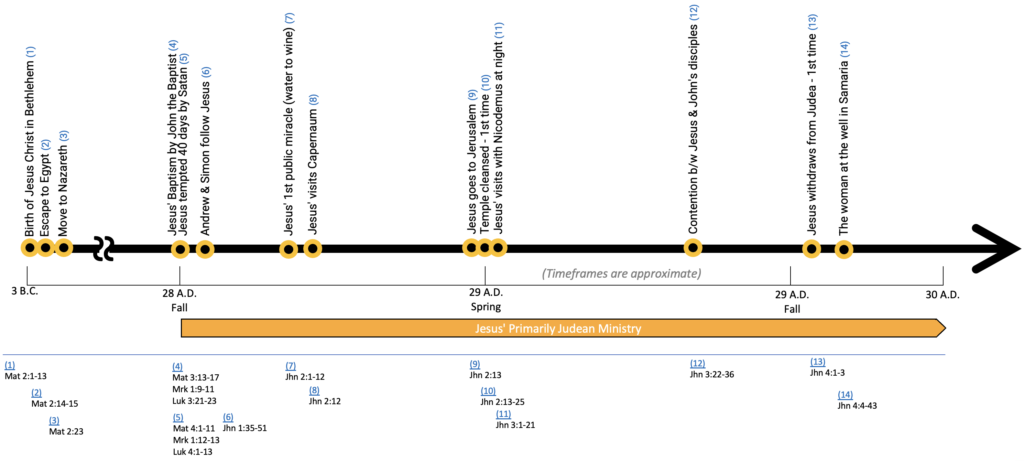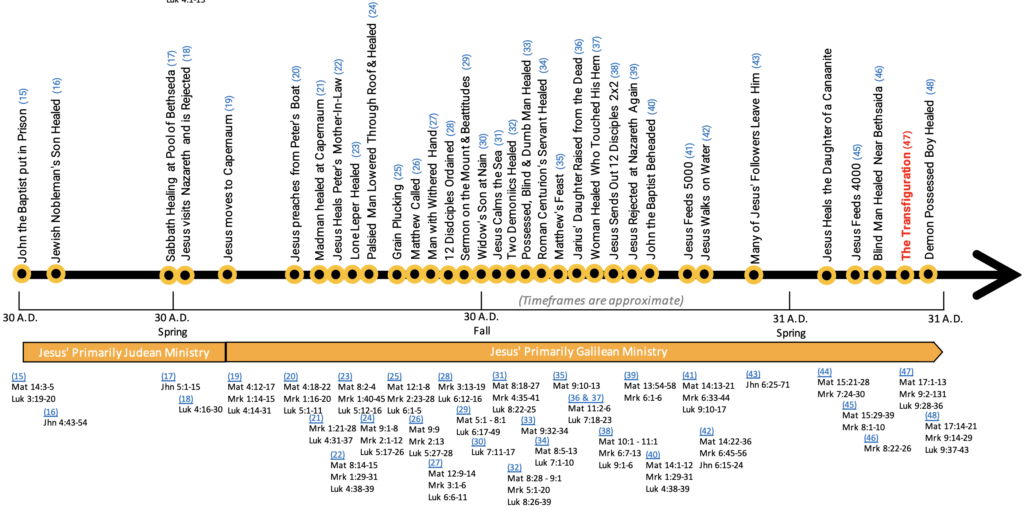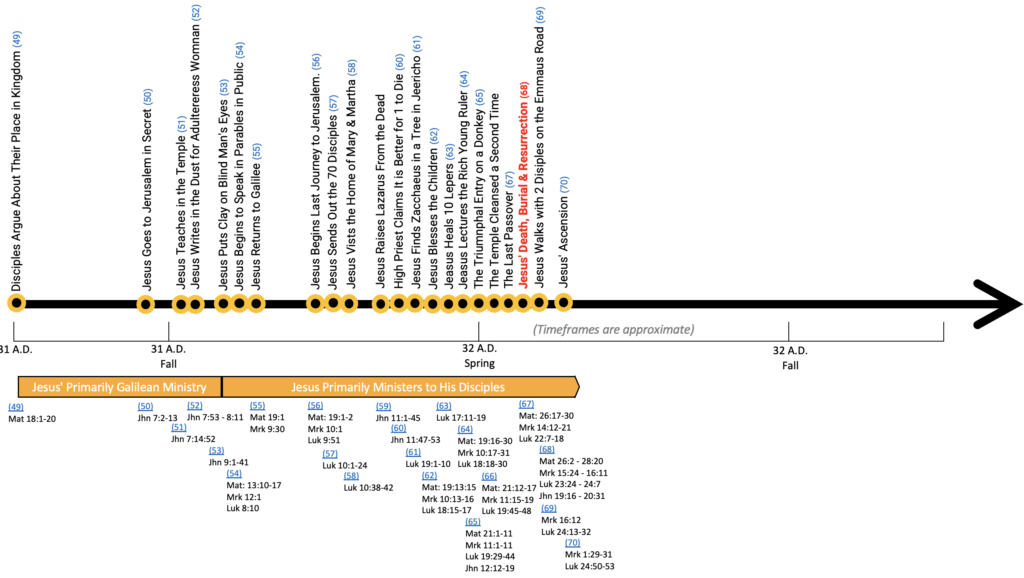Matthew
The Gospel of the Messiah
Summary | About | Why You Should Read it | Author | When Written | Context | Timeline | Location | Outline | Observations | Resources
Summary
The Gospel of Matthew is a biographical account of the lineage, life, death and resurrection of Jesus Christ. It starts at His birth and ends at His resurrection. It is written from the Jewish perspective and announces that Jesus Christ is the Messiah. The book of Matthew offers a logical conclusion to many of the Old Testament ceremonies, unachieved purposes, unappeased longings, and unfulfilled prophecies in the person of Jesus Christ, the Jewish Messiah.
This gospel contains over 60 Old Testament references, of which there were NONE in either Mark, Luke, or John. The following list is unique to the Gospel of Matthew.
- Visit of the Magi Mt 2:1-15
- Massacre at Bethlehem Mt 2:16-18
- Flight to Egypt Mt 2:19-22
- Return into Nazareth Mt 2:23
Ten Parables
- The Tares Mt 13:24-30
- The Hidden Treasures Mt 13:44
- The Pearl Mt 13:45
- The Dragnet Mt 13:47
- The Unmerciful Servant Mt 18:23-35
- The Laborers in the Vineyard Mt 20:1-16
- The Two Sons Mt 21:28-32
- The Marriage of the King’s Son Mt 22:1-14
- The Ten Virgins Mt 25:1-13
- The Talents Mt 25:14-46
Two Miracles
- The Two Blind Men Mt 20:30-34
- The Coin in the Fish’s mouth Mt 17:24-27
Nine Special Discourses
Matthew knew shorthand! It was required of a customs official (Mt 9).
- The Sermon on the Mount Mt 5-7
- The Invitation to the Weary Mt 11:28-30
- Idle Words Mt 12:36-37
- The Revelation to Peter Mt 16:17-19
- Humility and Forgiveness Mt 18:15-35
- Rejection of that Generation Mt 21:43
- The Eight Woes Mt 23
- The Prophecy on Olivet Mt 24:1-25:46
- The Commission and Promise Mt 28:18-20
Six Events of Final Week
- Conspiracy and Suicide of Judas Mt 26:14-1627:3-11
- The Dream of Pilate’s Wife Mt 27:19
- Resurrection of Saints Mt 27:52, 53 (after His Resurrection)
- Suggested Plot about His Body Mt 27:62-64
- The Watch at the Sepulcher Mt 27:65-66
- Earthquake Resurrection morning Mt 28:2
The next table is a high-level look at the structure and contents of Matthew.

About
The Gospel of Matthew is the first book in the New Testament. Its theme is in presenting Jesus as the King of the Jews, Israel’s long-awaited Messiah. In the 1st 12 chapters, Jesus teaches the multitudes until they reject his message and attribute His miracles to Satan. From then on, He teaches in parables publicly, only explaining them to His disciples.

Why You Should Read It
As the first book of the New Testament, it introduces Jesus Christ to us starting with His genealogy and His virgin birth. This genealogy starts with Abraham as the father of the Hebrew/Israelite family. The author of the book, Matthew, was a Hebrew and wrote this gospel from that perspective. It shows Jesus Christ as the fulfillment of the Law, the perfect Hebrew. It shows how He lived a sinless life and met all the obligations of the Law.
As described in the Summary section, Matthew provides details and insights not found in the other gospels. Matthew also shows how Jesus Christ fulfilled many of the Old Testament prophecies, with a number of references to those scriptures, unlike the other gospel writers.

Author
The author of this gospel is Matthew, also known as Levi, the son of Alphaeus (Mark 2:14). Matthew was a Jewish tax collector, working for the Romans to extract from his fellow countrymen what was considered an undue burden. As such, he was greatly despised by the Israelites. The profession of tax collector was on par with prostitution. He was not welcome in most public places, including the temple.
When Written
This book was written most likely in the timeframe of 58-68 A.D.
Context
Matthew wrote the original text of this gospel in Greek, the common language of the day and area. Although the Romans were in power and would eventually alter the common language to Latin, Greek was the language most commonly spoken in Israel at the time.
The account of the life of Jesus was written at a time when there was great persecution of the early church by both the unbelieving Jews and the Romans. This message was considered heretical to the unbelieving Jews and tyranny to the Romans. As such, the church of the day was primarily underground, in people private homes. Church gatherings were starting up due to the popularity of the message and the first-hand experience of many believers that were present for Jesus’ sermons and post-resurrection showing.
Matthew’s account is written from a very Jewish perspective. It was written by a Jew, to his countrymen, the Jews and about a Jew, Jesus, the long-awaited Messiah. Matthew was announcing Jesus as the Messiah.
Matthew had a skill of shorthand, required of tax collectors for the Romans. This enabled him to take detailed notes. As such, his gospel is the most detailed account of what Jesus said.
Timeline
Matthew chapter 1 lays out the genealogy of Jesus starting at Abraham. This is a logical starting point (the first Jew) for the very Jewish Matthew, who was a Levite. This clearly spans all of human history. Chapter 2 describes Jesus’ birth and early childhood years including the escape to Egypt.
The remainder of Matthew covers the time of Jesus’ ministry through to His resurrection. There are a number of conjectures relating to the exact years of His ministry and crucifixion. LearningGod.org’s position regarding the specific dating is based on a number of factors centering on the Daniel’s prophecy fulfilled by Jesus as recorded in Daniel 9:24-26. A detailed study of this prophecy and the associated history of events leading t it’s fulfillment can be found in Sir Robert Anderson’s “The Coming Prince” available in this link or in the Resources.
The dating resulting from this prophecy pinpoints to the exact day when Jesus would be presented as the Messiah, which is recorded in Matthew as happening a few days before His crucifixion on April 6, 32 A.D. Therefore, this gospel records the events from about October of 28 A.D. through to His ascension 40 days after His crucifixion.
This dating is further supported by Luke 3:1 (KJV), which says, “Now in the fifteenth year of the reign of Tiberius Caesar, Pontius Pilate being governor of Judaea, and Herod being tetrarch of Galilee, …” This is the start of Jesus’ ministry. The historian Josephus and Roman history both document the beginning year of Tiberius’ reign was 14 A.D. Thus, his 15th year would start in the year 28 A.D. and concluded in the year 29 A.D.
Location
Jesus was born in Bethlehem, spent a few early years in Egypt and then moved to Nazareth, from which He began His ministry. This ministry took place within what today is considered Israel. At the time, parts of it were controlled by gentiles, such as Samaria. The map below details the areas of His ministry. He did cross over the Jordan and preach west of Israel and also as far north as Tyre, which is in Lebanon today.
Outline
There are four main sections in Matthew. They are:
- Announcement & Arrival of the King 1-4
- Proclamation & Reception of the King 5-15
- Opposition & Rejection of the King 16-27
- Resurrection & Triumph of the King 28
A detailed outline follows.
The Birth and Early Years of Jesus (chs. 1-2)
His Genealogy (1:1-17)
His Birth (1:18 — 2:12)
His Sojourn in Egypt (2:13-23)
The Beginnings of Jesus’ Ministry (3:1 — 4:11)
His Forerunner (3:1-12)
His Baptism (3:13-17)
His Temptation (4:1-11)
Jesus’ Ministry in Galilee (4:12 — 14:12)
The Beginning of the Galilean Campaign (4:12-25)
The Sermon on the Mount (chs. 5-7)
A Collection of Miracles (chs. 8- 9)
The Commissioning of the 12 Apostles (ch. 10)
Ministry throughout Galilee (chs. 11-12)
The Parables of the Kingdom (ch. 13)
Herod’s Reaction to Jesus’ Ministry (14:1-12)
Jesus’ Withdrawals from Galilee (14:13 — 17:21)
To the Eastern Shore of the Sea of Galilee (14:13 — 15:20)
To Phoenicia (15:21-28)
To the Decapolis (15:29 — 16:12)
To Caesarea Philippi (16:13–17:21)
Jesus’ Last Ministry in Galilee (17:22 — 18:35)
Prediction of Jesus’ Death (17:22-23)
Temple Tax (17:24-27)
Discourse on Life in the Kingdom (ch. 18)
Jesus’ Ministry in Judea and Perea (chs. 19-20)
Teaching concerning Divorce (19:1-12)
Teaching concerning Little Children (19:13-15)
The Rich Young Man (19:16-30)
The Parable of the Workers in the Vineyard (20:1-16)
Prediction of Jesus’ Death (20:17-19)
A Mother’s Request (20:20-28)
Restoration of Sight at Jericho (20:29-34)
Passion Week (chs. 21-27)
The Entry of Jesus into Jerusalem as King (21:1-11)
The Cleansing of the Temple (21:12-17)
The Last Controversies with the Jewish Leaders (21:18 — 23:39)
The Olivet Discourse (chs.24-25)
The Anointing of Jesus’ Feet (26:1-13)
The Arrest, Trials and Death of Jesus (26:14 — 27:66)
The Resurrection (ch. 28)
The Earthquake and the Angel’s Announcement (28:1-7)
Jesus’ Encounter with the Women (28:8-10)
The Guards’ Report and the Jewish Elders’ Bribe (28:11-15)
The Great Commission (28:16- 20)
Observations
- Matthew is the gospel record:
- Written by a Jew – Matthew.
- Written to Jews – his countrymen.
- Written about a Jew – the long-awaited Messiah.
- Matthew uses quotes from the Old Testament to establish that Jesus Christ is indeed the Messiah.
- More than 130 times Matthew uses quotations and allusions to the Old Testament to show that Jesus fulfills the qualifications for the Messiah.
- Matthew often uses the phrase, “that which was spoken through the prophets ight be fulfilled.” That phrase does not appear once in Mark, Luke, or John.
- The phrase, “Son of David,” referring to the Davidic line, occurs 9 times in Matthew, but only 6 times collectively in Mark, Luke, and John.
- Matthew shows his Jewish readers that Jesus Christ is the culmination of promises delivered over a four-thousand-year period.
- Matthew shows that God’s redemptive plan is well even after 400 years of prophetic silence.
- Messiah means “the Anointed One.”
- Matthew gives a large reception in his house so his associates could meet Jesus. Matthew 9:10
- The last appearance of his name in the Bible is in Acts 1:13.
- The phrase, “kingdom of heaven” appears 55 times in Matthew.
- Matthew was a tax collector in Capernaum when Jesus called him to follow Him.
- As a publican (tax collector), Matthew was no doubt disliked by his countrymen.
- The turning point in the Book of Matthew comes in chapter 12 when the Pharisees formally reject Jesus as the Messiah, saying that His power comes from Satan and not from God. Christ’s ministry changes immediately with:
- His increased use of parables.
- Increased attention to his disciples.
- His repeated statements that His death is now near.
- The Book of Matthew is placed first in the canon of the New Testament books by the early church because of its natural bridge between the Old and New Testaments.




